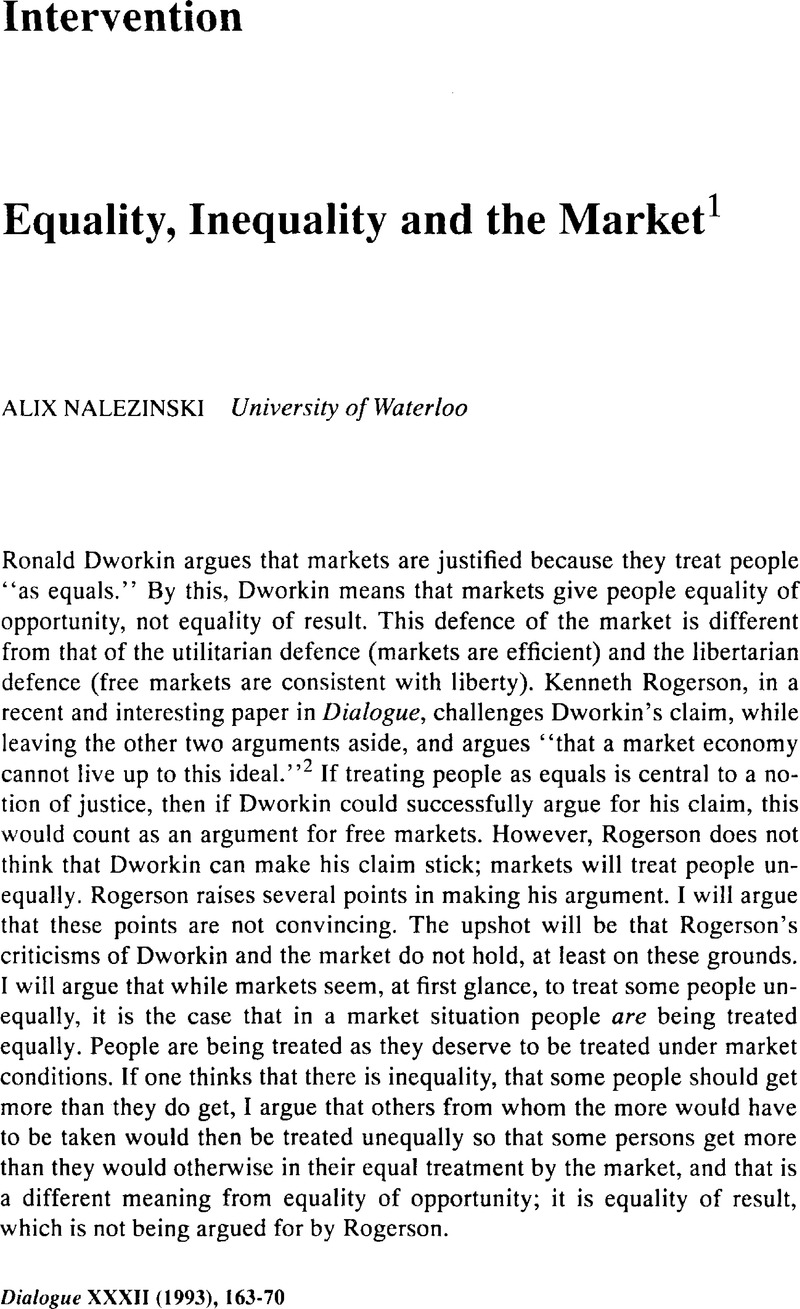No CrossRef data available.
Published online by Cambridge University Press: 13 April 2010

1 I would like to thank Jan Narveson for his helpful comments on an earlier draft of this paper.
2 Rogerson, Kenneth F., “The Inequality of Markets,” Dialogue, 28 (1989): 553–55.CrossRefGoogle Scholar
3 Ibid., p. 558.
4 Ibid.
5 It may seem that I am implicitly or indirectly bringing in the liberty argument to justify the car manufacturers' and workers' right to make as much money as they can. But I do not do this. I stick with the notion of equality of opportunity. In a sense, however, the notion of equality of opportunity allows for a sphere of liberty. The meaning of ‘in a sense’, though, is important because I am not presupposing the place of or need for liberty (as a separate element in the argument) in order to argue as 1 do, but I note that if one is to have an equal opportunity, then one is to have the liberty to seek that opportunity; otherwise one will not be able to seek the fulfilment of one's goal.
6 Those who disagree are making a category mistake, much like those who, when shown the buildings on campus, still ask to see “the university.” If only two humans interact, for example, Laurel and Hardy, then the results of their transaction are simply that: what they agreed to. There is no one or nothing which brings the result about independent of their choices. This is further illustrated by the example of only one person who has no one with whom to interact. The results of that person's choices are simply that: the choices he made. No one or nothing gave him Y (e.g., a pizza) when he had the means and brought about Y on his own; nor does he suddenly end up with the X(e.g., a coconut).
There is a further objection here which some people might want to raise. It is that the persons involved are in a master-slave relationship (except for the person who is alone). So, a person is imposing his wants on another, rather than the market doing so. But I think that the analogy does not work. A slave cannot leave his master when his work is done. The master can also abuse the slave if the master so wishes. Neither is true in the contract situation. If a person does not want to do something, he cannot be forced to do it. And being required to fulfil the terms of an agreement is not being enslaved, but simply being required to uphold one's end of the bargain. For example, being required to pay a carpenter the agreed price for the furniture one has her build and deliver is enforcing a contract, not enslaving a person. The person can be sued, but not abused. And one person cannot abuse another person against his will either for not wanting to do an action or for whatever other reason. The exceptions to this rule are the masochists and sadists who agree to inflict and receive pain on and from each other. But this is morally permissible because such an agreement is voluntary and is not a violation of the rule forbidding the involuntary infliction of pain.
7 Rogerson, “The Inequality of Markets,” p. 559.
8 Ibid., p. 560.
9 Ibid., pp. 560–61. It is not a fatal strike against Dworkin to point out that there are many other factors besides wages which can influence a person's job preference. But this point should be mentioned.
10 Ibid., p. 562.
11 Ibid.
12 Ibid., pp. 562–63.
13 Ibid., p. 564.
14 Ibid.
15 Ibid., p. 565.
16 Ibid.